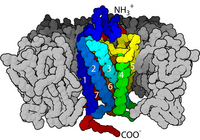
Mucus Penetrating and Cell‐Binding Polyzwitterionic Micelles as Potent Oral Nanomedicine for Cancer Drug Delivery
Sign Up to like & getrecommendations! Published in 2022 at "Advanced Materials"
DOI: 10.1002/adma.202109189
Abstract: Orally administrable anticancer nanomedicines are highly desirable due to their easy and repeatable administration, but are not yet feasible because the current nanomedicine cannot simultaneously overcome the strong mucus and villi barriers and thus have… read more here.
Keywords: mucus penetrating; mucus; oral nanomedicine; cell binding ... See more keywords

Susceptibility to Neutralization by Broadly Neutralizing Antibodies Generally Correlates with Infected Cell Binding for a Panel of Clade B HIV Reactivated from Latent Reservoirs
Sign Up to like & getrecommendations! Published in 2018 at "Journal of Virology"
DOI: 10.1128/jvi.00895-18
Abstract: Although antiretroviral therapies have improved the lives of people who are living with HIV, they do not cure infection. Efforts are being directed towards harnessing the immune system to eliminate the virus that persists, potentially… read more here.
Keywords: cell binding; hiv; infection; neutralization ... See more keywords

The Ectodomain of the Vaccinia Virus Glycoprotein A34 Is Required for Cell Binding by Extracellular Virions and Contains a Large Region Capable of Interaction with Glycoprotein B5
Sign Up to like & getrecommendations! Published in 2018 at "Journal of Virology"
DOI: 10.1128/jvi.01343-18
Abstract: Previous studies have shown that the vaccinia virus glycoproteins A34 and B5 interact, and in the absence of A34, B5 is mislocalized and not incorporated into extracellular virions. Here, using a transient-transfection assay, residues 80… read more here.
Keywords: a34; cell binding; interaction; extracellular virions ... See more keywords

Targeted Antimicrobial Photodynamic Therapy of Biofilm-Embedded and Intracellular Staphylococci with a Phage Endolysin’s Cell Binding Domain
Sign Up to like & getrecommendations! Published in 2022 at "Microbiology Spectrum"
DOI: 10.1128/spectrum.01466-21
Abstract: Antimicrobial resistance is among the biggest threats to mankind today. There are two alternative antimicrobial therapies that may help to control multidrug-resistant bacteria. ABSTRACT Bacterial pathogens are progressively adapting to current antimicrobial therapies with severe… read more here.
Keywords: antimicrobial photodynamic; therapy; biofilm; photodynamic therapy ... See more keywords

Crystal Structures of Botulinum Neurotoxin Subtypes A4 and A5 Cell Binding Domains in Complex with Receptor Ganglioside
Sign Up to like & getrecommendations! Published in 2022 at "Toxins"
DOI: 10.3390/toxins14020129
Abstract: Botulinum neurotoxins (BoNT) cause the potentially fatal neuroparalytic disease botulism that arises due to proteolysis of a SNARE protein. Each BoNT is comprised of three domains: a cell binding domain (HC), a translocation domain (HN),… read more here.
Keywords: binding domains; crystal structures; ganglioside; cell binding ... See more keywords

Structural Features of Clostridium botulinum Neurotoxin Subtype A2 Cell Binding Domain
Sign Up to like & getrecommendations! Published in 2022 at "Toxins"
DOI: 10.3390/toxins14050356
Abstract: Botulinum neurotoxins (BoNT) are a group of clostridial toxins that cause the potentially fatal neuroparalytic disease botulism. Although highly toxic, BoNTs are utilized as therapeutics to treat a range of neuromuscular conditions. Several serotypes (BoNT/A-/G,… read more here.
Keywords: botulinum neurotoxin; cell binding; binding domain;

A Comprehensive Structural Analysis of Clostridium botulinum Neurotoxin A Cell-Binding Domain from Different Subtypes
Sign Up to like & getrecommendations! Published in 2023 at "Toxins"
DOI: 10.3390/toxins15020092
Abstract: Botulinum neurotoxins (BoNTs) cause flaccid neuromuscular paralysis by cleaving one of the SNARE (soluble N-ethylmaleimide-sensitive factor attachment protein receptor) complex proteins. BoNTs display high affinity and specificity for neuromuscular junctions, making them one of the… read more here.
Keywords: structural analysis; cell binding; bont bont; bont ... See more keywords